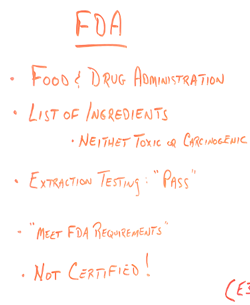Whitepapers On Whiteboard

Click on the image to open in a New Tab.
Understanding FDA, 3A, and NSF Standards for Food-Grade and Potable Water Applications

In industries dealing with food-grade materials and potable water, compliance with specific standards ensures safety, quality, and regulatory adherence. Three primary standards in North America—FDA, 3A Sanitary, and NSF—govern the materials and components used in these applications. Understanding their distinctions is crucial for manufacturers and suppliers.
FDA (Food and Drug Administration)
- Purpose: The FDA provides guidelines for materials that come into contact with food, ensuring they are safe and non-toxic.
- Regulation: Under 21 CFR 177.2600, the FDA lists acceptable ingredients for rubber compounds used in food contact applications.
- Compliance: Materials are considered FDA compliant if they are formulated from approved ingredients and pass specific extraction tests. It's important to note that the FDA does not "certify" materials; rather, it provides a framework for compliance.
3A Sanitary Standards
- Origin: Developed by the International Association of Milk, Food, and Environmental Standards, along with the Dairy and Food Industries Supply Association.
- Focus: These standards pertain to equipment and materials used in dairy and food processing, emphasizing cleanability and resistance to bacterial growth.
- Application: Materials must withstand rigorous cleaning processes, including exposure to chemicals and high temperatures, without degrading or harboring bacteria.
NSF (National Sanitation Foundation)
- Function: NSF International develops public health standards and certifies products for food, water, and consumer goods.
-
Key Standards:
- NSF/ANSI 51: Pertains to materials used in food equipment, ensuring they are safe for food contact.
- NSF/ANSI 61: Relates to materials used in drinking water systems, ensuring they do.
- Certification: Unlike the FDA, NSF conducts testing and provides certification for materials and products, confirming their compliance with the respective standards.
Summary Comparison
| Standard |
Governing Body |
Scope |
Certification |
| FDA |
U.S. Food and Drug Administration |
Food contact materials |
No |
| 3A Sanitary |
International Association of Milk, Food, and Environmental Standards |
Dairy and food processing equipment |
No |
| NSF |
NSF International |
Food equipment and drinking water systems |
Yes |
Understanding these standards ensures that materials and components used in food-grade and potable water applications meet safety and regulatory requirements.